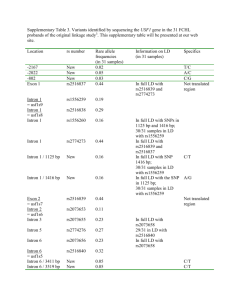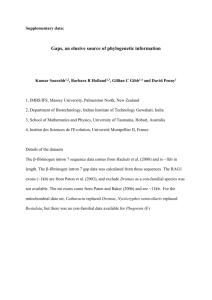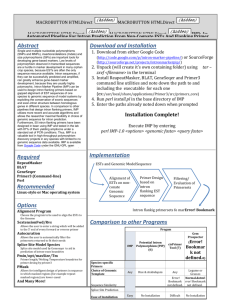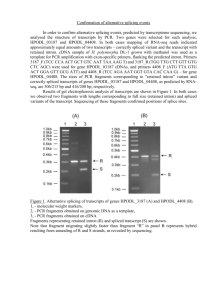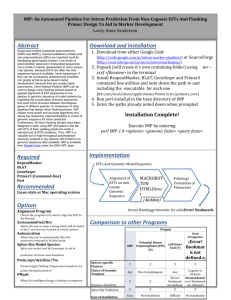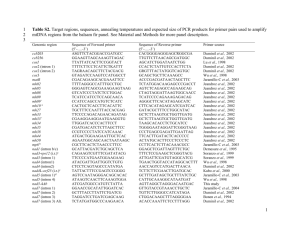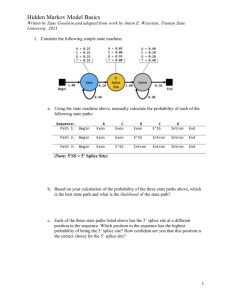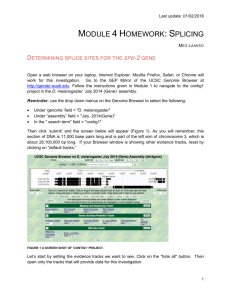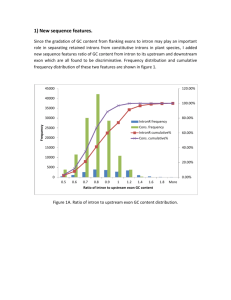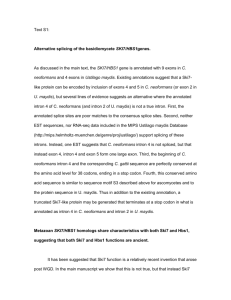Supporting Information
advertisement
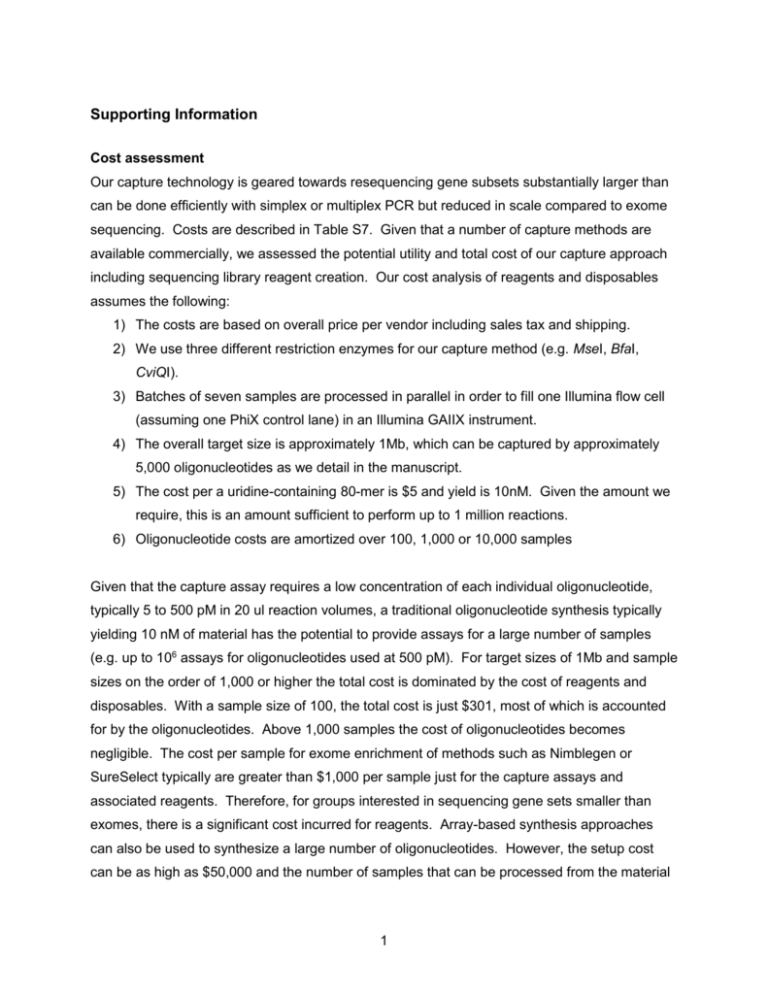
Supporting Information Cost assessment Our capture technology is geared towards resequencing gene subsets substantially larger than can be done efficiently with simplex or multiplex PCR but reduced in scale compared to exome sequencing. Costs are described in Table S7. Given that a number of capture methods are available commercially, we assessed the potential utility and total cost of our capture approach including sequencing library reagent creation. Our cost analysis of reagents and disposables assumes the following: 1) The costs are based on overall price per vendor including sales tax and shipping. 2) We use three different restriction enzymes for our capture method (e.g. MseI, BfaI, CviQI). 3) Batches of seven samples are processed in parallel in order to fill one Illumina flow cell (assuming one PhiX control lane) in an Illumina GAIIX instrument. 4) The overall target size is approximately 1Mb, which can be captured by approximately 5,000 oligonucleotides as we detail in the manuscript. 5) The cost per a uridine-containing 80-mer is $5 and yield is 10nM. Given the amount we require, this is an amount sufficient to perform up to 1 million reactions. 6) Oligonucleotide costs are amortized over 100, 1,000 or 10,000 samples Given that the capture assay requires a low concentration of each individual oligonucleotide, typically 5 to 500 pM in 20 ul reaction volumes, a traditional oligonucleotide synthesis typically yielding 10 nM of material has the potential to provide assays for a large number of samples (e.g. up to 106 assays for oligonucleotides used at 500 pM). For target sizes of 1Mb and sample sizes on the order of 1,000 or higher the total cost is dominated by the cost of reagents and disposables. With a sample size of 100, the total cost is just $301, most of which is accounted for by the oligonucleotides. Above 1,000 samples the cost of oligonucleotides becomes negligible. The cost per sample for exome enrichment of methods such as Nimblegen or SureSelect typically are greater than $1,000 per sample just for the capture assays and associated reagents. Therefore, for groups interested in sequencing gene sets smaller than exomes, there is a significant cost incurred for reagents. Array-based synthesis approaches can also be used to synthesize a large number of oligonucleotides. However, the setup cost can be as high as $50,000 and the number of samples that can be processed from the material 1 recovered from one synthesis is unclear. Therefore, oligonucleotide costs will dominate the total cost per sample. Sequencing costs are also proportional to target size for a given median fold coverage. We can routinely index 4 samples in a single lane of the Illumina GAIIx and achieve a median coverage greater than 100 over a 1 Mb target; whereas we need to combine 3 lanes of data for a single sample to achieve the same coverage when using exome capture. The recent increases in Illumina sequencing capacity due to the advent of the HiSeq2000 system make it even more cost effective to resequence candidate regions, genes and loci using our capture approach. We believe that targeting in combination with indexing is optimal for the following applications: 1) Populations studies sequencing >100 individual samples such as may occur in candidate loci resequencing for novel variants in genome wide association studies (GWAS). 2) Moderate target size of 1-10Mb. 3) Applications where deep resequencing is required, such as validation of candidate variants identified by genome scale discovery techniques or analysis of mixed samples such as solid tumors. 2 Supporting Tables Table S1. Commercially available 4 base recognition Restriction Enzymes HpyCH4V TGCA AluI AGCT HaeIII GGCC NlaIV GGNNCC CviQI GTAC BstUI CGCG Cac8I GCNNGC MseI TTAA TaqI TCGA Sau3AI GATC HhaI GCGC HpaII CCGG FatI CATG BfaI CTAG 3 Table S2. Genes included in each of the capture assays 10 genes (capture assay1) AKT1 106 genes (capture assays 2 and 3) AKT2 APC EGFR FRAP1 KRAS MARK3 SMAD4 TGFBR2 TP53 ABCA7 ACVR1B ACVR2A APC ARAF ARFRP1 ATM ATP5A1 BAI3 BRAF BRCA2 CABLES1 CACNA2D1 CAMKV CCND1 CCNE1 CDC42BPB CDH1 CDH10 CDH20 CDKN2A CHD5 CSMD3 CTNNA2 CTNNB1 CYFIP1 DACH2 DCC DCLK3 DLG3 EED EGFR EPHA3 ERBB2 ERN2 EZH2 FBXW7 FGFR3 FHOD3 FLG2 FOXP4 FRAP1 GPR124 GPR133 GRIA3 HM13 HNF1A IL2RG KBTBD11 KIT KLHDC4 KRAS MAP2K4 MAP2K7 MEN1 MGC16169 MLH1 MLL3 MSH2 MSH6 MYC MYH2 NAV3 NEK11 NF1 NF2 NRAS OMA1 OR10R2 PCDH15 PCDH18 PDZRN3 PIK3CA PPP1R3A PRKAA2 PTEN REM1 RET RIPK1 ROR1 ROR2 SF3B1 SLC1A6 SMAD2 SMAD3 SMAD4 SMARCA4 SMO SRC ST6GAL2 SUZ12 TAF1 TAF1L TCF4 TGFBR2 TNNI3K TNR TP53 TPO TRIO TRRAP TTK TTN TYK2 VHL ZNF521 The ten genes in bold represent a subset unique to capture assay 3. The remainder are genes common to both capture assays 2 and 3 4 Table S3. Analysis of factors affecting capture yield Parameter Capture assay 1 Capture assay 2 360 Oligonucleotides 2,341 Oligonucleotides Average Average fold- fold- Number coverage per Number coverage per Variable of oligos oligo target of oligos oligo target <100 1 9,232 34 589 <200 43 5,943 548 1,112 200-600 224 1,253 1,581 845 600-800 68 566 178 261 >800 24 119 > 75% 33 842 66 304 < 75% 327 1,709 2,275 876 No flap 124 1,824 835 1,229 195 1,690 1,318 687 41 756 188 429 Amplicon length target (bases) Targeting Arm %GC content Presence of flap structure Flap < 1kb Flap > 1kb 5 NA06995 - multiplex NA07037 - multiplex NA07435 - multiplex NA06995 - simplex NA07037 - simplex NA07435 - simplex Table S4. Reproducibility of simplex and multiplex capture yield. NA07435 -– simplex 1.00 NA07037 -– simplex 0.94 1.00 NA06995 -– simplex 0.95 0.92 1.00 NA07435 -– multiplex 0.96 0.92 0.91 1.00 NA07037 -– multiplex 0.96 0.91 0.91 0.98 1.00 NA06995 -– multiplex 0.95 0.91 0.94 0.95 0.97 1.00 Median fold-coverage 151.00 380.00 348.00 69.00 55.00 69.00 Average fold-coverage 399.14 878.22 856.40 173.73 147.99 201.73 6 Table S5: Novel SNVs Full table is available at http://oligoexome.stanford.edu/. 7 Table S6. Novel Indels Assay 106-gene 96-gene 106-gene Sample Gene Chr 2950 PRKAA2 1 PDZRN3 7037 18507 Gene location Genomic position RefSNP ID Intron 2-3 g.ch:1:56912938_56912939insT 11394634 3 Intron 3-2 g.ch:3:73734312delA 11343439 TRIO 5 Intron 29-30 g.ch:5:14451903delT 34806703 EZH2 7 Intron post 19 g.ch:7:148135650delG 3217095 EZH2 7 Intron pre 2 g.ch:7:148174627delA 3214332 TRRAP 7 Intron 38-39 g.ch:7:98391676_98391677insC 3214240 GPR124 8 Intron 14-15 g.ch:8:37815371_37815373delCTC NA RET 10 Intron 3-4 g.ch:10:42920331delCC 35906041 ATM 11 pre exon23 g.ch:11:107656918_107656919insA 3218681 NF1 17 Pre exon 14 g.ch:17:26570114_26570115insT NA PDZRN3 3 Intron 3-2 g.ch:3:73734312delA 11343439 BAI3 6 Intron 15-16 g.ch:6:69842768_69842769insA 35445308 TRRAP 7 Intron 11-12 g.ch:7:98341644delG 34508246 TRRAP 7 Intron 38-39 g.ch:7:98391676_98391677insC 3214240 RET 10 Intron 8-9 g.ch:10:42927766delC 34827976 MSH6 2 Intron post 7 g.ch:2:47886379_47886382delCTAT 2234731 PDZRN3 3 Intron 3-2 g.ch:3:73734312delA 11343439 PDZRN3 3 Intron 6-7 g.ch:3:73522799_73522800insA 35427155 EZH2 7 Intron post 19 g.ch:7:148135650delG 3217095 EZH2 7 Intron pre 2 g.ch:7:148174627delA 3214332 MLL3 7 Intron 58-59 g.ch:7:151465170_151465171insG NA GPR124 8 Intron 14-15 g.ch:8:37815371_37815373delCTC NA PCDH15 10 Intron 30-31 g.ch:10:55257406delA NA RET 10 Intron 8-9 g.ch:10:42927766delC 34827976 CYFIP1 15 post Exon 14 g.ch:15:20506749delC NA 8 Table S7. Cost analysis of the selective circularization method Category Type of reagent or disposable Enzymes Restriction enzymes Ampligase Taq polymerase UDG Phusion polymerase DNA ligase T4 polymerase T4 PNK Klenow T4 DNA ligase, HC dNTPS dATP Disposables Spin-20 column Fermentas PCR kit (2) E-Gel SizeSelect Gels, 3 PCR tubes Agarose Eppendorf tubes TBE buffer Cost per sample ($) 1.83 2.25 1.66 4.65 7.38 2.70 2.90 3.53 0.66 5.04 0.29 0.02 7.35 4.64 4.89 0.45 0.57 0.60 0.57 Total reagents and disposables: 51.98 Oligonucleotide costs uridine containing 80-mer ($ per oligonucleotide) total synthesis (5000 oligonucleotides) Oligonucleotide cost amortized over 100 samples 1,000 samples 10,000 samples Total cost per sample (reagents, disposables and oligonucleotides), amortized over : 100 samples 1,000 samples 10,000 samples 9 5.00 25,000.00 250 25 2.5 301.98 76.98 54.48 Table S8: Capture Oligonucleotides Full table is available on: http://oligoexome.stanford.edu/. Sequence, genomic location and concentrations used for each oligonucleotide. 10 Table S9. Primers for the universal vector. Vector oligonucleotide vector40 5’ - CTCGACCGTTAGCAAAGCTUUAGCCTTGTACCGTTATCGT – 3’ Universal PCR primer pair used in capture reactions forward_102 reverse_102 5’ - GGAGCTTTGCTAACGGTCGAG – 3’ 5’ - CCAGCCTTGTACCGTTATCGT – 3’ 11
